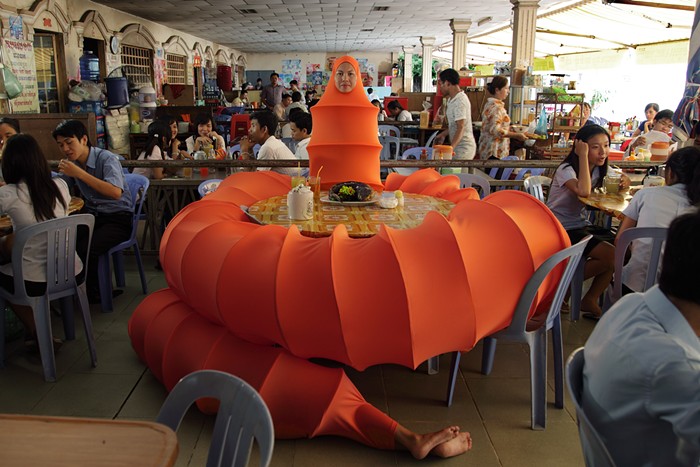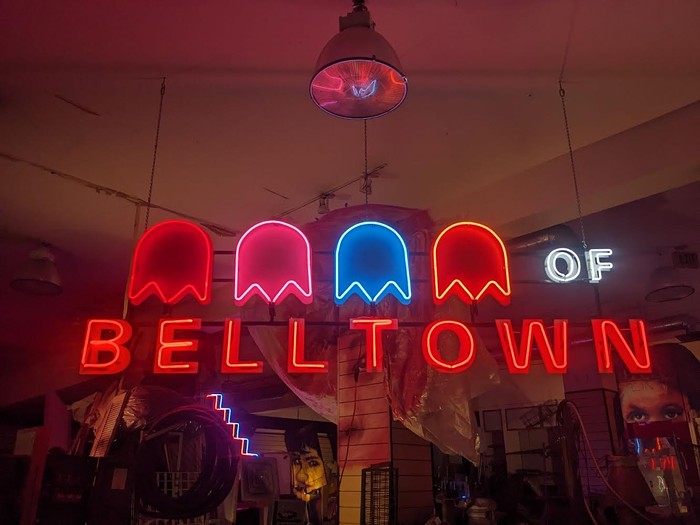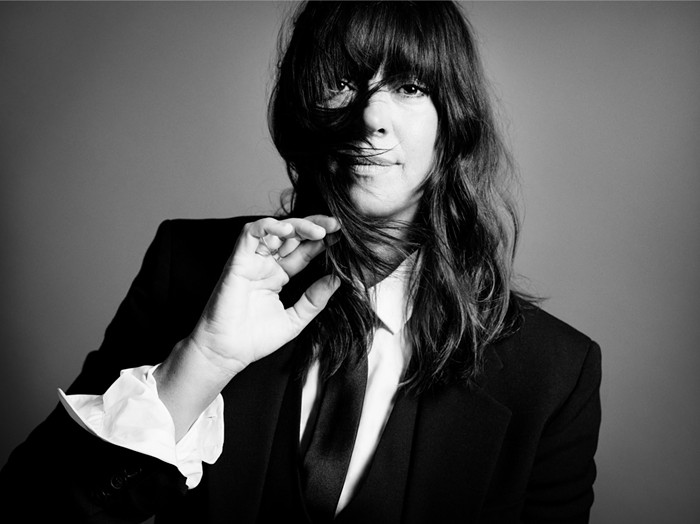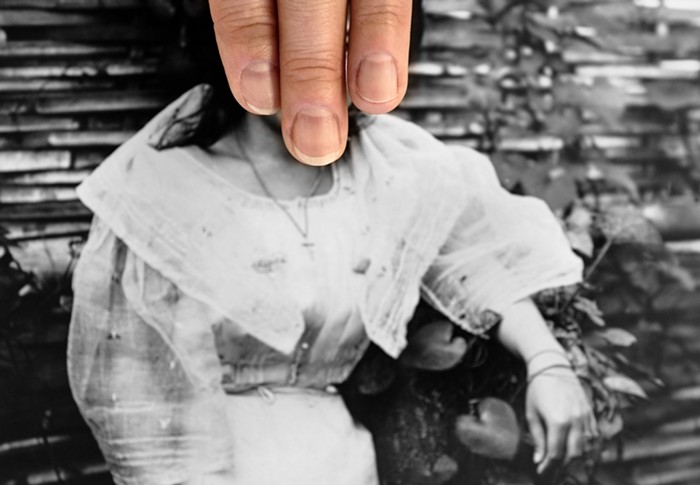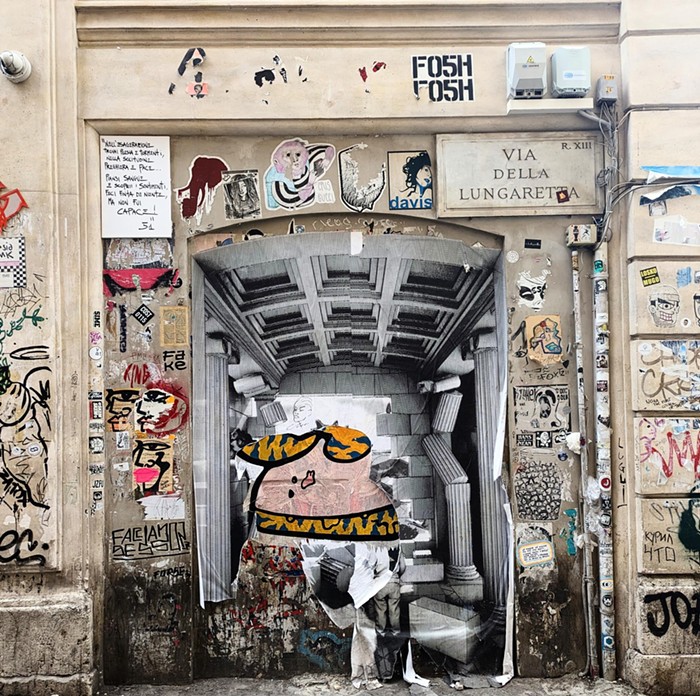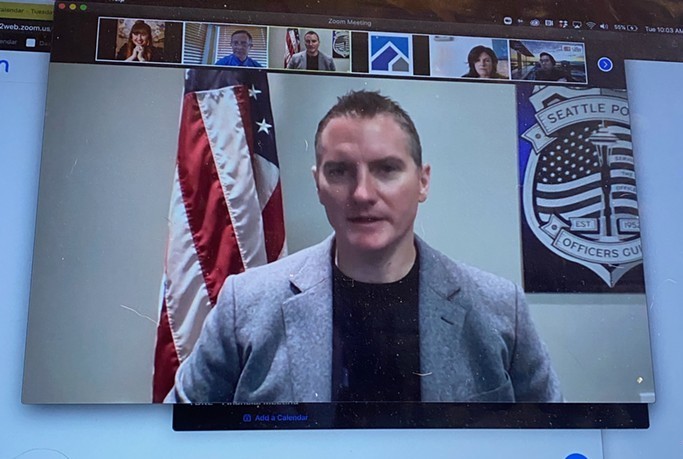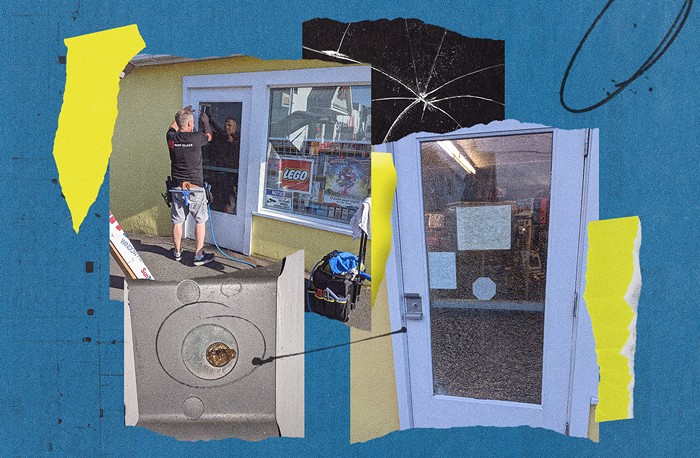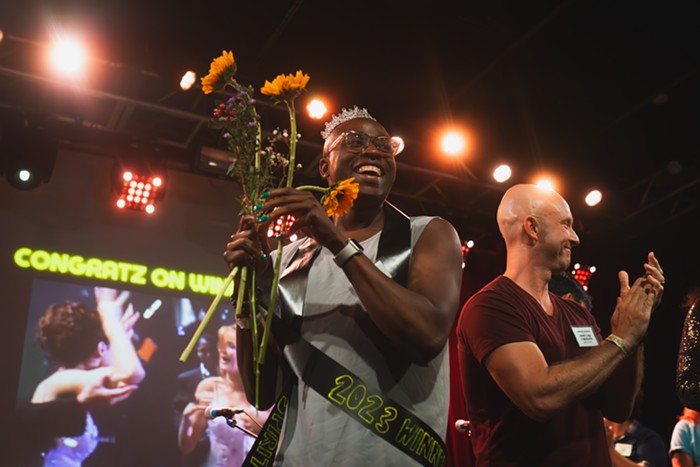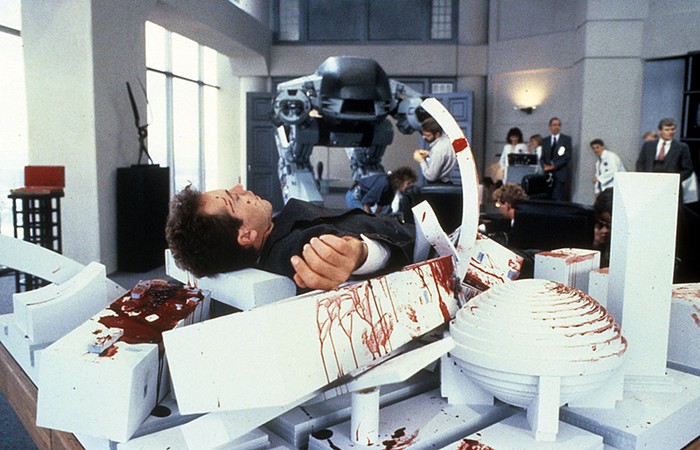When I say that I had a drink yesterday with Carl Chew at the Virginia Inn on the occasion of his show there now, I mean that I had the drink at the Virginia Inn, where the art is, and Carl Chew was at his Seattle home talking to me on the phone.
The reasons for this asymmetric alcoholing are too dull to describe, but suffice it to say that Carl Chew does not need a drink to be, in spirit, "drunken ceaselessly," to quote one of my favorite poemlets (shoutout to "the slums of Tacoma").
Just look at him!

I asked Chew a few questions, he gave a few answers. Here they all are, edited so that you will be bored by them as little as possible without leaving out smart things that may be more subtle, or making stuff up. (See, Chew makes you say things like that. His art, which he's occasionally sent to me in the mail over the years, out of the blue, brings on a sort of fever.)
Let's talk mail art. Are you a mail artist?
I prefer to call it "correspondance" art. I’m really into collaborating with people, which is more of a dance. It’s a term that Ray Johnson, the father of mail art, coined years ago. What we do is correspondancing. I am still a mail artist, yes, but I don’t like the confusion with m-a-l-e.
How are these big posters on the wall dancing?
Oh, it’s just the evidence of a dance. What’s on the walls is advertisements for the work. if you bought one of those things I wouldn’t give you what’s on the wall. It’s printed on lousy paper on gator board. I would print you one on handmade paper any size you want.
So what I'm seeing is the back-and-forths that have already taken place.
They are evidence of the back-and-forths, or they have elements that pertain to correspondance or mail art. They’re not all collaborations. But everything involves doing it and then mailing it to a bunch of people.
So all the posters that you see there, most have been mailed to numerous people and most of the people have done things to them and changed them and then sent them on.
They say they're editions, but no one’s ever bought anything from me in a long time, so if somebody wanted to buy one, I sort of have to think how many of these have I already given away to people.
Savvy sales strategy, you master capitalist! [Okay I didn't say that.] You mentioned that you have had a long career. How’d you start?
I was a zoology major in college, and I failed to graduate by one credit, which allowed me to go back and take art classes. I met a few people in the art school at the UW that I loved, and that was it.
Before that I’d never taken any art classes. My mother was a weekend painter, quite a good one, and my grandfather had been an etcher, an engraver, and we had examples of his work around the house, so printmaking was in my blood.
I eventually got an MFA in printmaking and video, and once I graduated, I came out with [Seattle artists] Bill Ritchie, Norie Sato, Carolyn Law, Mary Ann Peters.

So you grew up in seattle.
No, I moved here in 1967 to go to school in zoology. I thought I was going to be a marine biologist.
Where from?
Los Angeles.
And then you did become a science teacher, right? I've read about you. You got suspended for refusing the give the WASL and everything.
I did. I didn’t want to teach art because you know I’m not suited to teach color wheel and art theory and all that stuff. I think that’s not what kids should be taught, actually, but I also just didn’t want to teach art. Art is too personal to me to want to teach it to somebody.
All in all, I taught 15 years.
Are those two worlds separate for you, art and teaching?
Well, I still tutor. And one-on-one, the world of art comes in many times in my teaching. A lot of times it’s simply visualizing what they’re doing. You want to make a poem about your house? Draw me a map. What’s that? What’s this? Let’s take a walk through these pictures and then write down what you see. So then they use a visual map to write a poem about their house.
What kind of artist do you think you are? You're the kind who wouldn't want to teach color wheel, and there's a lot of mess on the surfaces of your work. Tell me about the mess.
Well I like to come right up to that edge where you’re not sure if you’re seeing fiction or not-fiction.
Things can be pretty messy most places but we look beyond that clutter. The unreal images are the ones that make everything look perfect. So those are the images that everyone wants to see. The real images show the clutter.
Lately I’ve been having problems with my eyes, I’ve had detached retinas. But I see all this stuff floating around, and I realize there’s layers of things.
It's like when you go outside in the summer, all of a sudden your focus will shift and you’ll see this huge cloud of flies right in front of you that you didn’t see because your focus was in a different place.
I like to imagine those layers.
Lately, in the Philatelic Life series, those layers are about ideas, not flies. How do you sandwich ideas between the image and the viewer?

[Thus far in our discussion I've been sitting and typing his words. At this point, he orders me around the room to a couple of his pieces, and then I sit back down at my keyboard. Now we're talking about his poster (above) for his show at the Whitney Museum of American Art.]
I never had a show at the Whitney. Many people get mad at me. I just want to be right there on that line, where you go, "Did this guy really have a show at the Getty or the Louvre? And then you think to yourself, no..."
Why do you want to be on that line, in that spot between fiction and nonfiction?
I don’t know. Some people have ADHD, I have this. In my personal life, it has caused me a lot of grief. My dad punished me for fibbing. My wife can’t understand my need to be between fiction and nonfiction. I don’t lie.
You don’t right-out lie.
Well, maybe I do. I’ve told a lot of lies in my time. Sometimes to, well, I just find lies more funny than the actual truth, which is close to the lie.
One of the most famous lies I tell, and everybody likes it, is that when I was in the seventh grade I made an envelope with a stamp on it—because I drew stamps as a kid, and this one had a worm coming out that read US Postage—and in science class I got called to the principal's office and there were postal inspectors there! They questioned me and I said "Yeah, I did it," and they said, "You can make stamps as much as you want, but don’t ever put 'US Postage' on them."
The actual truth is that I did get called out of my seventh grade science class and there were two postal inspectors waiting for me in the office, but the problem was you weren’t allowed to use postage-due stamps to mail letters with.
The postage-due stamps were for the postman to put on the envelope. He'd put it in your mailbox and you’d know you owed him money.
So that was the real story, which for seventh grade was pretty cool, but I think the story I’ve told for years is a better story.
The thing that's interesting is that if people saw me as as fiction writer, stuff like this would be considered normal. But I know that often, people think of visual artists as being nonfiction, or searching for the truth or something. They don’t expect visual artists to be fiction artists, they expect them to be nonfiction artists.
So if you tell a story like the one I just told you, is it a lie or am I just a fiction artist?
For instance, you look at one of my posters, that’s a real thing, it’s hanging there and you could assign a value to it and someone could take it home. But it’s fiction, too. But people want it to be genuine fiction, and they don’t expect non-genuine fiction. I don't know, I'm getting confused.
Me too! But I have a question. Let me ask you: Why do you think your story about "US Postage" is a better story than the real story about "postage-due"? Because it seems like it's funnier that they stopped you for doing something that would potentially bring the postman a nice little bit of pocket cash.
It might not be funnier. You’re the first person I’ve ever talked to about this.
But the thing is, you couldn’t buy these postage-due stamps, so anyone trying to use them as actual postage... Now, if the mail went through and the people actually paid, then that would be square.
So they never went through and no postmen got paid?
No, they were intercepted.
Will you ever stop mailing art?
I’ve been doing it since 1976 and I’m 68. I don’t think I’m going to stop anytime soon.
And how does a person get on your mailing list? What if there are artists out there who want to be on your list?
I’ve got too many people on my list! If they truly truly want to be a correspondance artist with me, they can do it by looking at my web site and Googling mail art and Ray Johnson, and they can figure out for themselves what to do.
Thank you for this. I hope you’ve been hearing our Motown background [playing in the bar as we talked].
I have!
When does your show close again?
The 28th of August.

